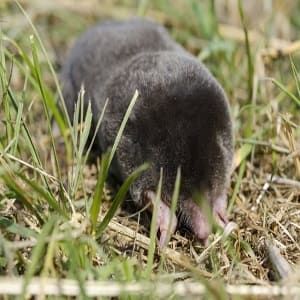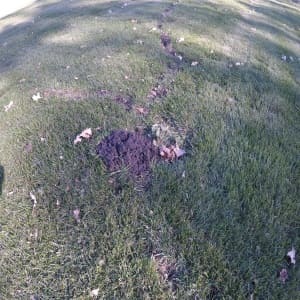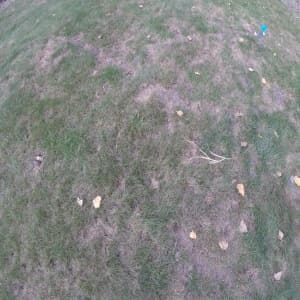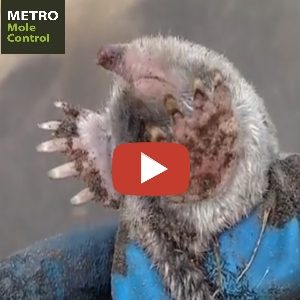Moles
CHARACTERISTICS OF MOLES IN MINNESOTA


Moles in Minnesota are 6 to 8 inches in length and weigh about 3 to 6 ounces, approximately the same size as a chipmunk. The most common mole found within the Twin Cities Metro and suburbs is the eastern mole which is native to Canada, Mexico, and the United States. Identifying characteristics of moles are beak-like noses, unseen eyes, no ears, velvety fur, and stubby hairless tails. They have many small teeth. Moles in Minnesota typically breed in April or May and have a litter size of 2 to 6 offspring. Rapid growth permits the young to leave the nest and survive on their own at about four weeks of age. Moles can live up to six years and can cause extensive property damage. In Minnesota, the most successful approach to mole control is through a dedicated in-season mole trapping program.
A moles diet consists of earthworms (85%), grubs, and insects. Above all, they are voracious predators and consume 25 to 50% of their body weight in food each day or about 45 to 50 pounds of food per year. In Minnesota, moles are active at all hours, with peak activity at dawn and dusk. Moles do not hibernate in the winter and live below the frost line.
MOLE PROPERTY DAMAGE IN MINNESOTA


Eastern moles live almost entirely underground in lawns, fields, and meadows. A mole can tunnel up to 100 feet in a single day. In search of food, they literally swim through the soil by digging with their short, outward-facing, spade-like front feet. Tunneling appears as a long series of “snake or vein-like” ridges on the surface of the lawn. The lawn will feel like spongy grass when walked on. This sinking feeling is caused by weight collapsing shallow mole tunnels. Surface tunnels often expose grass roots killing the grass and creating dead spots throughout the lawn. Although moles don’t eat plants, sometimes their digging disturbs roots, causing plants to die. They will also cut vegetation and use it as nesting and bedding material. In extreme situations, moles may undermine concrete sidewalks, driveways, swimming pools, and even shallow foundations. These situations can be extremely expensive to fix.
When digging new tunnels, the mole will push excess soil up through vertical shafts creating a volcano-like mound or “molehill.” Molehills lead to bare spots on the grass and can make lawn mowing challenging. Molehills are typically the result of deeper tunnel formation and in some situations may lead to large sunken areas as the tunnels collapse. This type of damage can be difficult to patch and often requires tilling, filling, and replanting. If not eliminated, moles will establish an extremely damaging tunneling network throughout the property, reproduce and become much more difficult to control with time. Mole tunnels can attract other nuisance animals like snakes, shrews, voles, and mice. If you live in Minnesota and have mole property damage, you should take mole control and removal action through a professional mole trapping program.
ADDITIONAL RESOURCES
A few additional resources to help you learn more about moles are as follows:
This video shows close-up footage of an eastern mole which is the most commonly found mole in Minnesota. Moles spend almost all of their time underground. Notice the paddle-like hands and large claws that help them dig and move quickly through the soil. They also have a long nose that helps them locate food consisting of earthworms, grubs, and insects. Moles cause damage by uplifting the soil while traveling around your property looking for food.
Wikipedia. “Mole (animal)“
J.P. and D.L. Iowa State Extension and Outreach. “Mole Problems Surface Early”
CONTACT US
For a free, no-obligation consultation/service estimate, please complete our information request form, email us at [email protected] or call us at (763) 350-0331.


